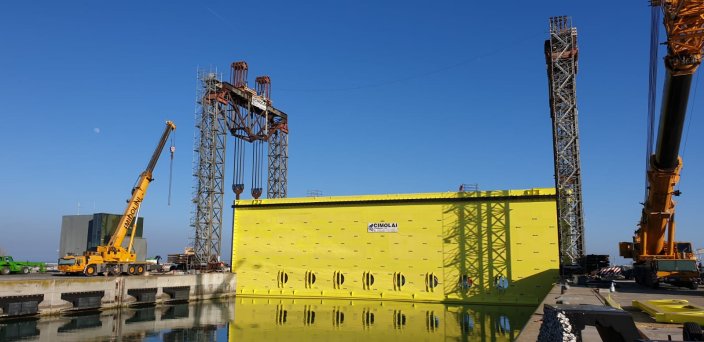Provveditorato Interregionale per le Opere Pubbliche per il Veneto, il Trentino Alto Adige,
il Friuli Venezia Giulia, tramite il concessionario Consorzio Venezia Nuova
GENERAL CONTRACTOR: Comar Scarl
TECHNICAL DESIGN: SBE
DETAILED TECHNICAL DESIGN (DTD): Cimolai S.p.A.
STEEL CONSTRUCTION: Cimolai S.p.A.
LOAD-OUT AND MARITIME HEAVY TRANSPORT: Cimolai S.p.A.
GRILLAGE AND INSTALLATION: Cimolai S.p.A.
MARINE WARRANTY SURVEYOR: Det Norske Veritas

The seaside gate of the navigation lock of the Bocca di Malamocco in Venice
provides access to the lagoon for maritime traffic when the sluice gates of
the M.O.S.E. are raised to protect the city from high water. Cimolai
S.p.A., specialized in special steel constructions, has constructed, in its
Monfalcone (GO) factory, a new seaside gate weighing 1860 t and measuring
54x16x7 m; it is an electro-mechanical structure equipped with ballast
chambers controlled by a hydraulic system and moved by winches on rails
anchored at a depth of 14 m. Cimolai also designed the land-based
transportation and loading, via SPMT, of the gate onto the Arcalupa barge
(which is owned by Cimolai), and the marine-based transportation from
Monfalcone to Malamocco, with appropriate grillage and seafastening
connections. The most spectacular operation carried out by Cimolai, however,
was the precision immersion of the gate into the lock, resting it on the
rails by means of 8+8 hollow jacks located on two 32 m high lattice portals,
placed on the two sides of the navigation lock.

Cimolai used the Straus7 finite element analysis system to develop a
complete FEM model of the gate for the numerous, in terms of quantity and
topology, design verifications for strength, deformation, buckling and
fatigue, with respect to the different configurations and load cases, in
particular related to the expected wave motion spectrum of loading.

In addition, various FEM models of the grillage were developed to simulate
the installation procedure, coupled with partial models of the barge itself
accelerated by the marine motions of the vessel, and the model of the
lifting portals, which allowed for the verification of strength and
deformation due to different load combinations during the navigation and
installation phases of the gate. Local FEM models were also developed for
the design of the special rigging, consisting of lifting anchors and
eyebolts integrated into the top of the gate.

Text, photo and images of finite element model, courtesy of Cimolai S.p.A.
|
The seaside gate of the navigation lock of the Bocca di Malamocco in Venice provides access to the lagoon for maritime traffic when the sluice gates of the M.O.S.E. are raised to protect the city from high water. Cimolai S.p.A., specialized in special steel constructions, has constructed, in its Monfalcone (GO) factory, a new seaside gate weighing 1860 t and measuring 54x16x7 m; it is an electro-mechanical structure equipped with ballast chambers controlled by a hydraulic system and moved by winches on rails anchored at a depth of 14 m. Cimolai also designed the land-based transportation and loading, via SPMT, of the gate onto the Arcalupa barge (which is owned by Cimolai), and the marine-based transportation from Monfalcone to Malamocco, with appropriate grillage and seafastening connections. The most spectacular operation carried out by Cimolai, however, was the precision immersion of the gate into the lock, resting it on the rails by means of 8+8 hollow jacks located on two 32 m high lattice portals, placed on the two sides of the navigation lock. |

|
Cimolai used the Straus7 finite element analysis system to develop a complete FEM model of the gate for the numerous, in terms of quantity and topology, design verifications for strength, deformation, buckling and fatigue, with respect to the different configurations and load cases, in particular related to the expected wave motion spectrum of loading. |

|
In addition, various FEM models of the grillage were developed to simulate the installation procedure, coupled with partial models of the barge itself accelerated by the marine motions of the vessel, and the model of the lifting portals, which allowed for the verification of strength and deformation due to different load combinations during the navigation and installation phases of the gate. Local FEM models were also developed for the design of the special rigging, consisting of lifting anchors and eyebolts integrated into the top of the gate. |

Text, photo and images of finite element model, courtesy of Cimolai S.p.A.


